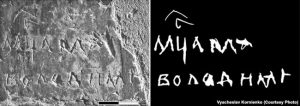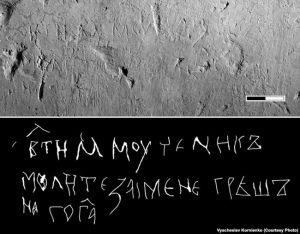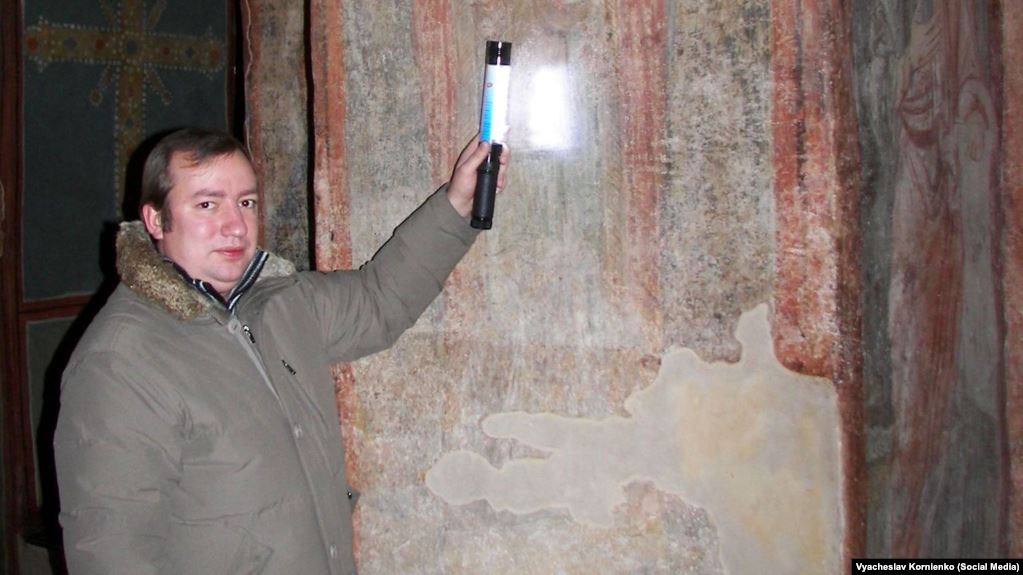- We call it the Old Ukrainian language. Our philologist and researcher of the Reims Gospel, Viktor Moiseyenko, found that the author of the Gospel had rewritten the text, reproducing some features of Church Slavonic in the Ukrainian version. He copied some of the passages as he heard them, and corrected others if he saw that he had written a wrong letter, modifying it according to the canons of Church Slavonic.
I'd like to point out that the linguistic features of the Reims Gospel have a close analogy to the ancient graffiti in St. Sophia Cathedral in Kyiv.

- Can you tell us more about the graffiti at St. Sophia Cathedral?
- We’ve recorded a considerable number of Ukrainianisms from the 11th-12th
centuries. We were getting ready to publish the inscriptions on the choir galleries of St. Sophia Cathedral. For example, there’s an inscription from the 12th century – “соромно бути” (to be is shameful), and there are also references to Prince Volodomyr. Incidentally, on our graffiti, he’s never mentioned as “Prince Vladimir”… and criminal cases and commercial disputes were considered “на суді” (in court, in Ukrainian), not “на суде” (in court, in Russian).
The inscription about Prince Yaroslav’s funeral reads: “In the 6562th (1054 year) month of February 20th, the burial of our king will take place on Sunday, the week of Martyr Theodore”. That is, “успіння” (assumption, burial, in Ukrainian), not “успение” (assumption, burial, in Russian).


- So, what conclusions can be drawn?
- Based on all our research and studies of written memorials, we can confidently say that the population of ancient Kyivan Rus spoke a language that can be called Old Ukrainian, as philologists would say.
To date, we have recorded over 7,000 graffiti on the walls of St. Sophia Cathedral in the following languages: Church Slavonic texts in Ukrainian version, texts written in Cyrillic, Glagolitic, Greek, Latin, Polish, Armenian, German, English and Czech.
- The Ukrainian language is very rich, and it contains many profane words, among other things. Do you think Ukrainians used swear words at that time?
- Of course, people were well aware of such specific words. We can find some abusive inscriptions on the walls of St. Sophia; some of them are very closely related to modern obscene terms. However, there aren’t so many of them. I think people realized that they were in a sacred area and that it was not the right place to insult their neighbours.
- Let’s get back to Church Slavonic… Why was it so popular?
- Church Slavonic was a universal language used for written communication. It was understood by Slavic peoples. The language was based on Moravian and Bulgarian languages. It had a significant influence on modern Slavic languages, especially on Ukrainian that grew out of a compromise style and incorporated many Church Slavonic elements into the native Ukrainian vernacular by the 14th century.

The Cyrillic section of the Reims Gospel is a cultural artifact of the Ukrainian language dating back to the 11th-12th centuries. It was probably written in the Kyiv scriptorium of St. Sophia Cathedral. The second passage, written in the Glagolitic script in the 14th century, comes from Croatia. Today, the Reims Gospel is stored in the Reims Library, Reims, France.

